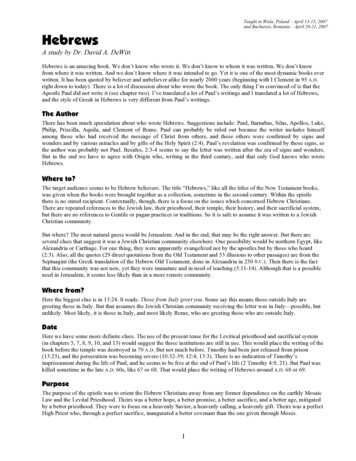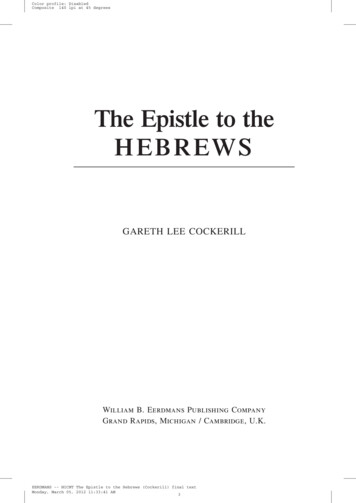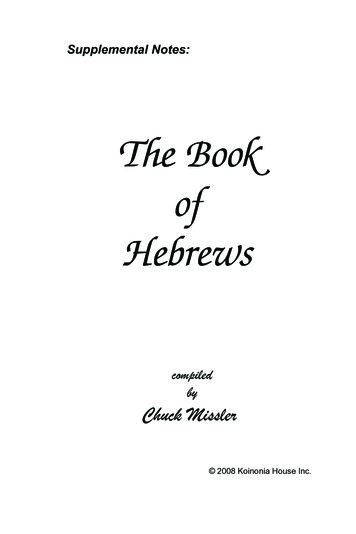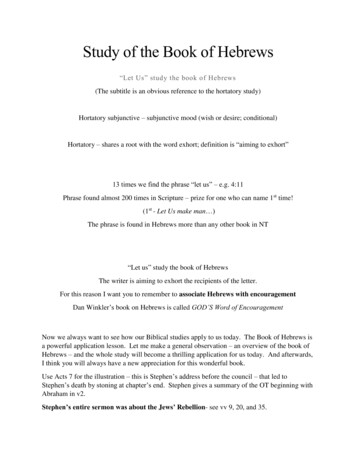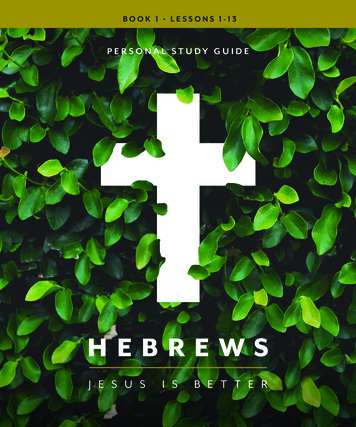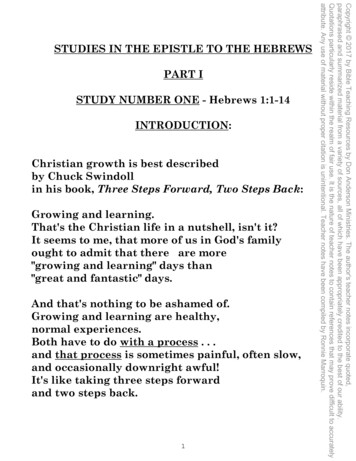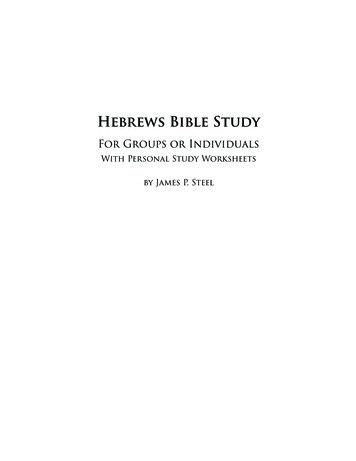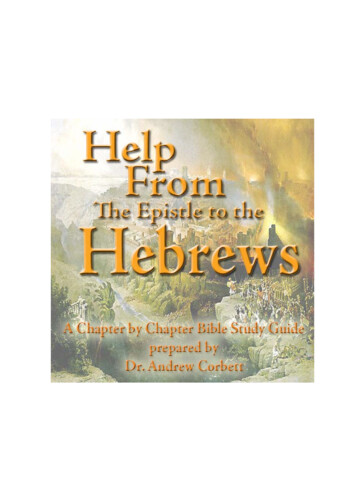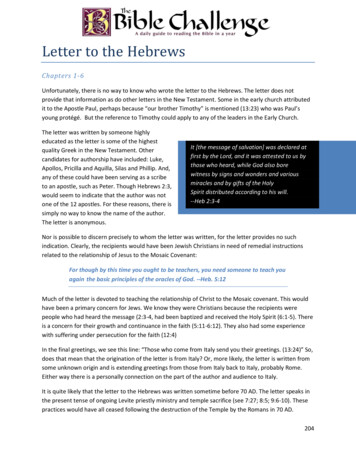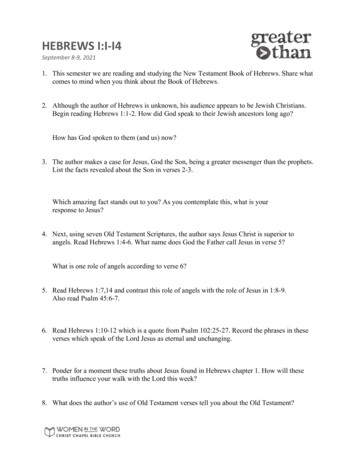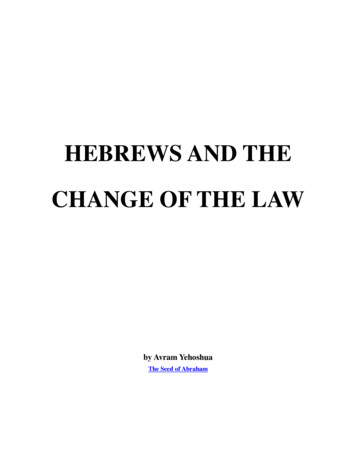
Transcription
HEBREWS AND THECHANGE OF THE LAWby Avram YehoshuaThe Seed of Abraham
TABLE OF CONTENTSHEBREWS AND THE CHANGE OF THE LAW 1HEBREWS 8:13—THE OLD COVENANT IS OBSOLETE 1Why Did God Destroy the Temple? 4Father Abraham and the New Covenant 7HEBREWS 7:12 AND THE CHANGE OF THE LAW 9Hebrews 7:18—Annulling the Commandment 11HEBREWS 10:4—AN OBTUSE VERSE 14GOD’S DEFINITION OF LOVE 16What is Sin? 18Three False General Interpretations 21Paul the Apostate? 23The Church and Israel 25THE PRIESTHOOD: JUST WHAT HAS CHANGED? 26MOSAIC LAW AND THE BELIEVER 28Amplified Commandments 33Divorce 33Enemies 34Modified Commandments 34Illegitimate Children 34Redemption of Firstborn Sons and Male Animals 35The Blessings and the Curses 35The Stubborn and Rebellious Son 36Tithes to the Priests 36Where to Celebrate the Feasts 37Negated Commandments 37Physical Covenantal Circumcision for the Gentile 37Put On Hold Commandments—Until the Millennium 39Stone the Witch! 39The Holy Spirit 40CONCLUSION 41Salvation and the Law 41Hebrews and the Law 42Practical Suggestions 43Our Well Meaning Friends and Family 44BIBLIOGRAPHY 46Articles Cited 47iii
HEBREWS ANDTHE CHANGE OF THE LAWby Avram YehoshuaThe Seed of AbrahamProper interpretation of God’s Word is vital for understanding what God means and ensures that we arewalking out our faith in Messiah Yeshua the way that He wants us to, and not according to the traditionsof the Church that nullify the Word of God. Most Christians wrongly believe that the Law of Moses was‘done away with’ and not applicable for them1 because of certain New Testament passages that have beenmisinterpreted or mistranslated and used as ‘proof texts’ against the Law, four of which are found in thebook of Hebrews (8:13; 7:12, 18; 10:4). Once these verses are correctly understood their use as scripturalproof against the Law disappears, and actually, the four verses uphold the Old Covenant and validate theLaw of Moses for every Christian.HEBREWS 8:13THE OLD COVENANT IS OBSOLETEHebrews 8:13 is one of the truly reflexive verses in Scripture. By reflexive I mean a Scripture that theChurch uses to support their anti-Law theology, but when the verse is allowed to speak for itself, it’s plainto see that the Old Covenant is still valid.2 The first part of the verse doesn’t seem to be that way, and thisappears to be what many build their false position on:‘And when He said a New Covenant, He has made the first obsolete’ (Heb. 8:13a).From just this part of the verse it seems that the Old Covenant is gone, and with it, of course, the Law ofMoses, but before we get into the second part of the verse, which defines obsolete, note well what the author of Hebrews is actually saying when he writes, ‘when He (God) said a New Covenant ’ The authorhad just finished quoting from Jeremiah (Heb. 8:8-12), what God had said about a New Covenant, 650years earlier.3 The very fact that God spoke of a New Covenant in Jeremiah immediately made the Old123A common theological position on the Law of Moses is that only the so-called moral laws transfer over into theNew Testament, but if the penalty for breaking the Sabbath was death (Ex. 31:12-17; 35:2), yet stealing livestockwas forgivable (Ex. 22:1), which would seem morally greater in God’s eyes? If disobedience to God is morallywrong, breaking His Sabbath is a sin of great magnitude. God, not Man, determines what is moral, and breakingany of God’s laws is immoral and sin (Mt. 5:19; Rom. 7:7, 12; 1st John 3:4).Another reflexive Scripture is 1st Timothy 4:4-5, where the qualifications for what is ‘food to eat’ entails bothprayer and the Word of God, which in Paul’s day included the Old Testament dietary laws (Lev. 11; Dt. 14; 2ndTim. 3:14-17). Christians usually ‘miss’ that the food is ‘sanctified by the Word of God and prayer,’ not justprayer.Jeremiah 31:31 is the only place in the Old Testament where the phrase ‘New Covenant’ appears.
obsolete, meaning that, from that moment on it was on its way out, but obviously, neither God, nor the author of Hebrews, meant that the Old was literally done away with in the days of Jeremiah, as is evidentfrom the verse itself (‘the days are coming;’ Jer. 31:31). This concept, of the Old being obsolete, yet stillvalid, is what the author of Hebrews intends for us to understand, even though the New Covenant hadbeen inaugurated about 35 years earlier. He confirms this understanding in the next part of the verse.In Heb. 8:13b he qualifies ‘obsolete,’ and reveals that even though the Old is obsolete (compared to whenthe New will be fully manifest), the Old was still as valid in his day, as it was in Jeremiah’s day:‘Now, what is becoming obsolete and growing old is ready to vanish’ (Heb. 8:13b).The three words in bold italics, ‘becoming obsolete growing old’ and ‘ready to vanish,’ are all meant toemphasize that the Old Covenant, and by extension the Law of Moses, hadn’t been tossed into the trashbin of history when Hebrews 8:13 was written. Yet, Hebrews is dated about 35 years after the resurrection,4 when the Church would tell us that the Mosaic Covenant and the Law had already been done awaywith (at the cross). If Christian theology was right, one would have expected the author to have writtenthis: “Now, what is obsolete and has grown old has vanished.” If that had been written, then the Churchwould be justified in tossing out both the Old Covenant and the Law.Paul Ellingworth, a respected theologian, realizes the dilemma and writes, in his detailed commentary onHebrews, that “the continued existence of the first covenant is never completely denied.”5 Although, as aChristian, he believes that it is (now) obsolete, it only shows us how, on the one hand, theologians cancorrectly translate the Word of God concerning the Law and the Old Covenant, but on the other hand,misinterpret it away. In this case they do that by appealing to the destruction of the Temple in 70 AD, fouror five years after Hebrews was written. The author, in speaking of ‘ready to vanish,’ wasn’t meaning thedestruction of the Temple, but the ‘soon’ coming of Christ. Like all the writers of the New Testament, heenvisioned the imminent return of Messiah Yeshua6 (i.e. the New Jerusalem; Rev. 21:1f.).Ellingworth, commenting on the phrase ‘ready to vanish’ (‘soon disappear’ in some translations) says,“The statement falls short of saying that the old cultus has already disappeared.”7 Ellingworth makes a4567J. D. Douglas, M.A., B.D., S.T.M., Ph.D., organizing editor, The Illustrated Bible Dictionary, part 2 (Leicester,England: Inter-Varsity Press, 1998), p. 629. A ‘date before 64 AD would be possible,’ or 67-68.Merrill F. Unger, The New Unger’s Bible Dictionary (Chicago: Moody Press, 1988), p. 548. ‘It seems clear thatthe Temple was still in existence and the ritual still continued. The present tense is repeatedly used in thisconnection (8:4, 13; 9:4-9; 10:1-10; 13:10-11).’ Unger suggests a dating of Hebrews at 67-69 AD.Geoffrey W. Bromiley, General Editor, Everett F. Harrison, Roland K. Harrison and William Sanford LaSor, Associate Editors, The International Standard Bible Encyclopedia, vol. one (Grand Rapids, MI: William B. Eerdmans Publishing Company, 1979), p. 692. ‘Before 70 AD.’Paul Ellingworth, translation consultant, United Bible Societies; I. Howard Marshall and W. Ward Gasque, editors, The New International Greek Testament Commentary: The Epistle to the Hebrews (Grand Rapids, MI:William B. Eerdmans Publishing Company, 2000), p. 418.James wrote that ‘the coming of the Lord is at hand’ (Jam. 5:8; ca. 48 AD).Paul writes in 1st Thess. 4:15-17; 5:4 (ca. 50 AD) about being alive when the Lord returns. In 1st Cor. 15:51-52(ca. 52 AD) he says that not all of them will die (see also 1st Cor. 1:7; 7:29-31; 8:29). In Romans 16:20 (ca. 56AD) he says, ‘The God of peace will shortly crush Satan under your feet,’ and in Phil. 4:5 (ca. 61 AD) he saysthat ‘The Lord is near.’Peter’s writes, ‘for the end of all things is at hand’ (1st Pet. 4:7; ca. 62 AD).Hebrews 1:1-2 speaks of it being the ‘last days’ (ca. 66 AD).John says that ‘it’s the last hour’ (1st John 2:18; ca. 80 AD), and speaks of Messiah’s imminent return (Rev.1:1-3; 22:20), and that the things he writes about would take place shortly (Rev. 22:6-7, 10, 12; ca. 95 AD; cf.Luke 19:11-27).Ibid., p. 419.2
link between the Old Covenant and the ‘old cultus’ (i.e. the Temple and its sacrificial rites in Jerusalem),but there is no justification for this since the author of Hebrews has been speaking of the covenants, notthe Temple, from Heb. 8:6-12, with 8:13 specifically dealing with both covenants. Nowhere does the author even hint at the destruction of the Temple, nor its equation with the ‘end of the Old Covenant,’ butthis is the standard theological explanation of the verse in light of anti-Law theology. Theologians pintheir theology, of the Law and the Old Covenant’s demise, on the Temple’s destruction, but if the Oldhadn’t yet vanished by 65-66 AD, when Hebrews was written, their equating it to the Temple’s destruction, and trying to use Heb. 8:13 to do it, is their idea, not God’s, for Hebrews 8:13b definitively declaresotherwise.Donald Guthrie, another theologian of note, writes that the word for obsolete in 8:13a is in the perfecttense, “which suggests that the first covenant has already become obsolete,” but he adds that the sameverb is used in the second part of the verse “as a present participle, becoming obsolete,”8 which revealsthat the Old Covenant hadn’t yet been negated. This, too, though, is theologized away when he states that,in practice it was a “gradual process,” which again confirms that the Old wasn’t done away with ‘at thecross,’ which is a major problem for the Church’s position. Guthrie, along with Ellingworth, say thatwhen the Temple was destroyed the time for the Old Covenant and its Law had come to an end. One canonly wonder what they would say about the future ‘Temple of Ezekiel,’ as it’s called (Ezk. 40–48) with itsMosaic Law, Levitical high priest and sacrifices in full operation, and that, at the direction and authorityof the Prince—the Messiah of Israel.9Donald Hagner, a third Christian theologian ‘witness,’ confirms that the Old Covenant hadn’t left thestage of history when the Letter to the Hebrews was written, stating, in relation to Heb. 8:13, that “it willsoon disappear.”10 He presents the usual Christian explanation of the verse by saying that from the perspective of the writer of Hebrews, the Temple is “outmoded and pointless and cannot last long.”11 It’s interesting to compare this Christian evaluation of the Temple and its rites with all the Apostles, who notonly met in the Temple, but also sacrificed there 25 years after the resurrection (Acts 21:20-24). Perhapsthe Apostles didn’t understand the Law as these Christian theologians do? Progressive revelation?Thirty-five years after the resurrection, Hebrews 8:13 spoke of the Old Covenant being obsolete, but notyet gone. It wasn’t gone in Jeremiah’s day, even though the Temple was destroyed,12 and it certainlywasn’t gone when the Temple was standing, and it’s not yet vanished in our day, either, even though thereis no Temple. With Messiah’s sacrifice the New Covenant came, and the Old, being obsolete,13 was sealed8910111213Donald Guthrie B.D., M.Th., Ph.D., author; Leon Morris, M.Sc., M.Th., Ph.D., general editor, Tyndale New Testament Commentaries: Hebrews (Leicester, England: Inter-Varsity Press, 2000), p. 178.Isaiah 9:6-7; 11:1-13; 19:19-22; 32:1; 33:20-24; 66:23; Ezk. 40–48; Luke 1:32; Rev. 20:4-6. Ezekiel 34:24 and37:25 both speak of the Prince as God’s servant David, which is a euphemism for the Messiah, who is the Son ofDavid (2nd Sam. 7:1f.; Mt. 1:1, 6, 17, 20; 9:27; 20:31; 22:42f., etc.). So, when Ezekiel again speaks of ‘thePrince’ (Ezk. 44:3; 45:7, 16, 22; 46:2, 4, 8, 10, 12, 161-8, etc.), it’s not unreasonable to think that it’s the Messiahthat Ezekiel is speaking about there, too.Donald A. Hagner, author; W. Ward Gasque, New Testament editor, New International Biblical Commentary:Hebrews (Peabody, MA: Hendrickson Publishers, 1990), p. 124.Ibid.I realize that Yeshua hadn’t come with the New Covenant in the days of Jeremiah and the destruction of the FirstTemple, but the point is that just because the Second Temple, its priesthood and sacrifice, stopped in 70 AD, itdoesn’t mean that it ended forever. God built the Second Temple under Ezra and Nehemiah, and will build theThird Temple for the Millennial Kingdom of Messiah Yeshua in ‘this’ Jerusalem (Ezk. 40–48).Obsolete doesn’t mean done away with, at least not yet. My 2009 iMac is obsolete, as Apple doesn’t make itanymore, but it’s still in good working condition. The written Mosaic Law is also obsolete, and on Judgment Dayit will disappear, but its rules and commandments were specifically designed by God for New Testament believers, even without the Temple, while they are on this Earth. God’s Law, given at Sinai, always had a NewCovenant purpose. God made it that way.3
for extinction. The Old is obsolete and will vanish, but that won’t happen until the New is fully manifested. Yes, Messiah’s work of redemption is completely ‘finished’ (Jn. 19:30), and we walk in it, to a degree, but it’s not fully manifested or fulfilled. Only when believers are glorified will the New Covenant befully manifest. Until then, the Old, with its written code (i.e. the Law of Moses), remains (for every believer in Yeshua). This is what the author of Hebrews is saying.The chronic inability of theologians to properly interpret what the author of Hebrews presents in 8:13,and also, throughout the New Testament where the Law is spoken of, is endemic.14 This is nothing lessthan Christian Pharisaism.15 The Pharisees, too, had their theological reasons and erudite explanations involving Scripture for all their traditional interpretations that nullified God’s Word (Mt. 15:1f.).Why Did God Destroy the Temple?God destroyed both the the First Temple, in 586 BC, and the Second Temple, 656 years later, in 70 AD,by using the armies of pagan nations that were the world power of their day, Babylon and Rome, respectively (Jer. 25:9; 26:18; Mt. 24:1f.). If the Old Covenant, though, was fulfilled (i.e. ‘done away with’)when the Second Temple was destroyed in 70 AD, why do we see Temple, Levitical priesthood and ritualsacrifice (i.e. the ‘heart’ of Old Covenant Law) showing up again in Ezekiel 40–48 for the thousand yearreign of Messiah Yeshua from this earthly Jerusalem (Rev. 20:1-6)?The Jerusalem Temple was supposed to be an earthly reflection, a true and holy copy of the heavenlyTabernacle or Temple, the dwelling place of the Father, where Yeshua is the High Priest, just as the original Tabernacle and First Temple symbolized.16 The controlling leadership of the Temple, though, afterYeshua’s ascension into Heaven, never turned to accept Him for who He is, nor for what He accomplishedfor them and all Israel, and therefore, the Temple was no longer a true copy of the Tabernacle or dwellingplace of God the Father and His high priest in Heaven, with its sacrifice on the heavenly Altar (Rev.11:1).17For 40 years the religious establishment denied Yeshua, and in direct parallel, denied what God the Fatherhad done for Israel. This is the reason that God the Father ordained the destruction of the Second Temple,40 years after the death and resurrection of His Son, because it had blatantly failed to be an accurate re14151617Endemic: a disease or condition regularly found among a particular people.Christian Pharisaism began around 100 AD, when the Roman Catholic Church, despising the Jews and ‘everything’ Jewish, even Jews who loved Yeshua, threw out the ‘Jewish’ Law. To justify it they denounced the Law asevil and ‘done away with by Christ.’ When Protestantism came on the scene in Europe (ca. 1500 AD) there werea number of important changes made to Christianity, but the Reformers overlooked Catholic theology on MosaicLaw. It wasn’t until the 1970s that the Holy Spirit began to open Christian eyes to the truth of the Law as the believer’s guideline for walking out their faith in Messiah Yeshua.Ex. 25:8-10, 40; 26:30; 40:18f.; Is. 6:1-2f.; 1st Chron. 28:9-12f.Yeshua’s eternal, one time for all, sacrifice is a reflection of the daily sacrifices (Ex. 29:38-43; cf. Lev. 6:12-13)because a lamb was always to be on the bronze Altar of Sacrifice, always calling to remembrance the sacrifice ofthe lamb in Egypt that secured Israel’s preservation of their firstborn sons and their freedom from Egyptian slavery, a symbolic eternal picture of the sacrifice of the Lamb of God. Although it doesn’t specifically say that ‘theLamb’ is on the heavenly Altar, it does speak of Him as being seen by John as a lamb that had been sacrificed(Rev. 5:6), and the fact that there is a sacrificial altar on Earth implies its counterpart in Heaven (Rev. 6:9; 11:1,and possibly, also 14:18; 16:7), with a sacrifice on it, the eternal sacrifice, which corresponds to the daily sacrifices of the earthly Tabernacle and Temples. These, along with the fact that Yeshua is the heavenly High Priest,and the primary function of a priest is mediation between God and Man through sacrifice, point to the Altar inHeaven having the Lamb on it. This sacrifice will remind all of us, through eternity, of the cost to Yeshua for theforgiveness of our sins and our glorification. (Also, John writes of Yeshua being the Lamb of God slain, and that,before the foundation or Creation of the Universe; Rev. 5:6, 12; 13:8).4
flection of its heavenly counterpart symbolizing God’s Truth and Ways, the greatest of which was thegiving of His Son for Israel’s sins and eternal glory; not because its destruction signaled the end of theMosaic Covenant. Forty is the number of testing.18 God the Father gave the high priestly leadership, theearthly authority and symbol of the Jewish people, 40 years to repent for rejecting His Son, and becausethey didn’t, the Father authorized the destruction of the Second Temple. Israel was tested after the resurrection and it failed. It was the religious leaders as a whole, not everyone, though, as Nicodemus andJoseph of Arimathea bear witness to, and who no doubt picture others in leadership who gave their livesto the Messiah of Israel (cf. John 10:19-21; 12:42), but the majority failed. By the end of 40 years, fromthe crucifixion and resurrection, the (Second) Temple in Jerusalem was no more.The Lord’s copy of what is in Heaven will be re-established in Jerusalem for the earthly presence andreign of Messiah Yeshua. It will then be a perfect copy, meaning that it will be a true copy, as seen fromwhat Peter says, just after the outpouring of the Holy Spirit on that historic Shavu’ot (Pentecost) after theresurrection, and what James says in Acts 15 (about 18 years later):“Repent, therefore, and turn to God, that your sins may be blotted out, so that times of refreshing may come from the presence of the Lord, and that He may send Yeshua the Messiah, who was preached to you before, whom Heaven must receive until the times ofrestoration of all things, which God has spoken by the mouth of all His holy Prophetssince the world began.” (Acts 3:19-21)“And after they had become silent, James answered, saying, ‘Men and brethren! Listen tome! Simon has declared how God, at the first, visited the Gentiles to take out of them apeople for His own name, and with this the words of the Prophets agree, just as it is written: ‘After this I will return and will rebuild the Tabernacle of David, which has fallendown. I will rebuild its ruins and I will set it up so that the rest of mankind may seekYahveh, even all the Gentiles who are called by My name, says Yahveh, who does allthese things.’ Known to God from eternity are all His works.’” (Acts 15:13-18)God has taken the Temple away for a long season (1,982 years and counting), but this is conceptuallysimilar to what He did with the First Temple, in the days of Jeremiah, because of the nation of Judah’s rebellion against His ways (the Law) and their propensity for sacrificial-sexual idolatry.19 Yet, as He broughtthe Temple back, in the days of Ezra and Nehemiah, so too, He will bring it back for Israel in the latterdays. This is what the thousand year, Messiah led, Temple of Ezekiel pictures—the glorious fulfillment ofthe Abrahamic, Mosaic and Davidic Covenants. With Messiah Yeshua reigning for a thousand years as thePrince (i.e. King of Israel),20 the earthly Temple will be a true reflection of what is in Heaven; MosaicLaw and Levitical sacrifice will be instituted and the Law will be kept the way that God always desiredfor Israel to keep it, from the inside-out, by His Spirit.God’s holy Law was given to Israel ‘after the flesh,’ but God gave the Law to Israel at Mt. Sinai with Israel ‘after the Spirit’ (Gal. 6:16) in mind. His holy ways and rules are His holy ways and rules both beforeand after Christ, with Yeshua showing us the essence of some of the laws and how amplified they are for181920The number 40 symbolizes testing: Yeshua fasting in the Wilderness (Mt. 4:2f.); the 12 Hebrew spies in Canaanfor 40 days (Num. 13:25); and Israel in the Wilderness for 40 years because of their refusal to trust God to bringthem into the land that He had promised to them (Num. 14:33-34); Moses fasting (twice) for 40 days, and also,Elijah.Jer. 2:20; 3:6; 7:31; 19:5; 32:35; Ezk. 16:4-25; 20:31. The International Standard Bible Encyclopedia explainsthat the reason for the destruction of both kingdoms was because the people of God were infatuated with sacrificial-sexual cult harlotry: ‘The captivity of the half-tribe of Manasseh resulted from their participation in the religious prostitution connected with the Canaanite gods (1st Chron. 5:25). The same can be said of the fall of boththe northern and southern kingdoms as the idolatrous practices they followed included such rites (Ezk.16:16-58).’ Bromiley, The International Standard Bible Encyclopedia, vol. one, p. 617.Ezk. 34:24; 37:25; 44:3; 45:7, 16, 22; 46:2, 4, 8, 10, 12, 16, 17, 18, 21, 22.5
those in His Kingdom. The Father set His Law in motion on the first Shavu’ot (Pentecost)21 at Mt. Sinai,when He gave the Law to Israel, and 1,470 years later,22 on another Shavu’ot, He sent His Spirit to indwell Israel (Acts 2:1f.). Now, with His Spirit, Israel, both Jew and Gentile who love Yeshua, can walk inGod’s holy laws, just as Messiah Yeshua did (1st John 2:6; 3:3-4). After all, isn’t Yeshua supposed to beour example in all things?As for the Law of Moses being the guideline for living out one’s faith in the Messiah of Israel, this is explicitly presented by Yeshua when He revealed the essence of some of the commandments of the Law. Forinstance, He said,“You have heard that it was said to those of old, ‘You must not commit adultery,’ but Isay to you that whoever looks at a woman to lust for her has already committed adulterywith her in his heart.” (Matthew 5:27-28)Yeshua explained the deeper and more profound meaning of the Law for His Kingdom on this Earth (Mt.5:17ff.). It’s certainly not meant for Heaven, and it certainly wasn’t possible for Israel to keep it withoutbeing Born Again and filled with His Spirit. This is the New Covenant—the writing of the Law, as understood and interpreted by Messiah Yeshua, on our minds and hearts (Jer. 31:31-34, esp. v. 33). It is only byHis Spirit that we have the potential to keep the Law, as God always intended for it to be kept, just likeMessiah did, and specifically as Yeshua spoke of (Mt. 5:17-19). For now, though, the Temple, LeviticalPriesthood, and Mosaic sacrifice have been ‘put on hold,’ but it’s not because Old Covenant Law hasceased to be valid for believers in Christ Jesus.The earthly Temple was destroyed, just as Yeshua said it would be (Mt. 24:1f.), because its leadershipnever embraced Him as part of God the Father’s New Covenant. The earthly Temple didn’t reflect whatwas in the Heavens. If the focus of the earthly had been on Yeshua, the earthly would have remained. Oneday the Temple will be re-established in Jerusalem, with Prince Messiah being the central person and focal point. Temple life and sacrificial rituals will be done in accordance with what is in the heavenly realmand then the earthly will be a true copy and reflection of what is in the heavenly:“In that hour Yeshua rejoiced in the Spirit and said, ‘I thank You, Father, Lord of theHeavens and the Earth, that You have hidden these things from the wise and prudent, butrevealed them unto babes. Even so, Father, for so it seemed good in Your sight’ ThenHe turned to His disciples and said privately to them, ‘Blessed are the eyes which see thethings you see, for I tell you that many prophets and kings have desired to see what yousee, and have not seen them, and to hear what you hear, and have not heard them.’” (Luke10:21, 23-24)In these last days, the God of Israel has unearthed His treasure, Mosaic Law, from the dustbins and cobwebs of Christian theology. Now is the time that He has chosen to reveal more of His words and His waysto the Body of Messiah, in preparation for Messiah’s imminent return and reign.2122Shavu’ot (Pentecost) is an annual Sabbath. See Pentecost—Shavu’ot to see how both the Law (the Word of God)and the Spirit were given on the same day, Shavu’ot (also known in English as the Feast of Weeks), coming 50days or 7 x 7 weeks plus one day after First Sheaf in Passover Week (Ex. 34:22; Lev. 23:4-16; Num. 28:26; Dt.16:9-10, 16).1,470 years breaks down into interesting numbers: 700 plus 700 plus 70, or 777. Seven is the number of holinessand completion, as first seen in the seven day week of Creation.6
Father Abraham and the New CovenantAn Old Testament illustration of the concept behind the phrase, ‘He has made the first obsolete’ (Heb.8:13a) is seen in the promise that God gave to Father Abraham. God promised that He would give himmany descendants, the land of Canaan and that He would be their God,23 but Abraham never owned a single acre of land in Canaan except for Sarah’s and his burial plot, which he bought with his own money!This is spiritually significant—‘death to self’ being needed before the promise is fulfilled or manifested.In Joshua, four hundred years later, God began to fulfill the promises—after the Sons of Israel had ‘diedto self’ in their 40 years of aimless wanderings because of their contempt and unbelief (Num. 13-14), buttheir many sons came into the land of Canaan and it became Israel’s, and Yahveh was their God. The finalearthly fulfillment of the Old Covenant will be when Yeshua, the Son of Abraham, Isaac, Jacob and KingDavid, reigns for a thousand years in Jerusalem (Rev. 20:1f.).In Yeshua’s death and resurrection, God began to fulfill the New Covenant, which He had spoken of 600years earlier. The promises given to us for today are realized in being Born Again, forgiveness of sins, theHoly Spirit and transformation of our nature, but who is glorified? Who is in the New Jerusalem withGod, now?24 We, unlike Father Abraham,25 have an immediate down payment of the promise, but no oneis glorified except Yeshua. Even the Apostles await Judgment Day, when all flesh shall stand before theKing. It’s then that the promise will come to fulfillment (‘until all is fulfilled,’ as Yeshua says in Mt. 5:18),and then the Old Covenant and the Law will be obsolete and vanish away, but not a moment before that.On Judgment Day God’s promise that the Law would be written on our hearts will be fulfilled (Jer.31:33)—it will be our nature because the Law is the verbal/written reflection of the character and will ofGod, and our nature will reflect it, just as Yeshua’s nature does, or more properly, the written code reflectsYeshua’s nature. That’s why it’s holy. This is the promise we await—that we will be exactly like He isnow, only that He was always God the Son, while we will be deity by creation, through His sacrificialblood.26 He is the God-Man and we shall be the God-Man’s Bride. This is our faith—we wait for thepromise to be fulfilled, just as Father Abraham did.The Mosaic Covenant is obsolete, when compared with the New Covenant’s fulfillment. This is what Heb.8:13a/b means, but it will only vanish on Judgment Day when the New is fulfilled. The written Law, as interpreted by Messiah Yeshua for His Kingdom, is still needed because we are in earthly vessels of clay,and God’s Law isn’t fully written on our hearts, but that’s what the Holy Spirit is trying to do—write theLaw of Moses on our hearts. Jeremiah 31 is the only place in the Old Testament where the term, NewCovenant, is literally spoken of, and reveals some of God’s purposes in giving the New Covenant, one ofwhich is to write the Law of Moses on the heart of every Christian:31“‘Behold! The days are coming,’ says Yahveh, ‘when I will make a New Covenant withthe House of Israel and with the House of Judah—32not according to the covenant that Imade with their Fathers in the day that I took them by the hand to lead them out of theland of Egypt, My covenant which they broke, though I was a husband to them,’ says23242526Gen. 15:1-21; 17:1-22; Dt. 9:4-5; 10:22.Mt. 3:11; 9:6; Mk. 2:10; 10:30; Lk.
tors, The New International Greek Testament Commentary: The Epistle to the Hebrews (Grand Rapids, MI: William B. Eerdmans Publishing Company, 2000), p. 418. 6 James wrote that ‘

